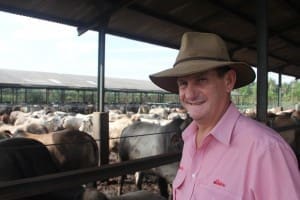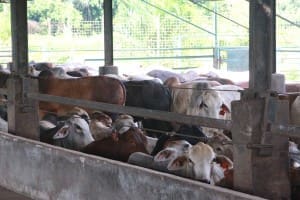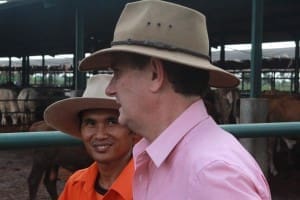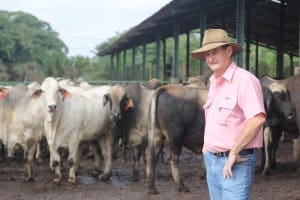
Elders’ Dick Slaney is one of the Australian cattle industry’s most experienced stakeholders in Asia.
Richard Slaney is one of those rare people who seems to have squeezed several lifetimes worth of experience into one.
In the past 12 years Richard, best known as Dick, has become a leading figure in Australia’s cattle trade with Indonesia, as he has developed and managed Elders’ large integrated feedlot, abattoir and beef marketing business in the country.
It is a demanding role that involves managing a diverse business with exposure to every link in the beef value chain, and doing so in a complex environment with different rules, different customs and a different culture.
But, just like any other Australian who has been drawn to the ever-changing, rarely-predictable business that is Australia’s live cattle trade with Indonesia, Dick isn’t your basic risk-fearing, faint-hearted individual.
In the 35 or so years since he left boarding school in Charters Towers and threw a swag over his shoulder and set off north in search of adventure, Dick has amassed a unique diversity of experience across all sectors of the supply chain that seems to have positioned him perfectly for his current role.
On a recent trip to Indonesia, Beef Central asked Dick over smoko how a boy from Charters Towers came to be where he is. 20 minutes later he was still giving the answer. Not because he was labouring the point, but simply because there was so much to fit in.
The dramatically edited version goes something like this:
- Dick was raised on a cattle property between Townsville and Charters Towers;
- After leaving school he cut his teeth as a ringer, head stockman and outstation manager for several years in the Queensland Gulf and WA Kimberley regions;
- He worked on a live cattle ship to South America, then spent the next 11 months working as a cowboy on a ranch in Venezuela;
- After returning to Australia he studied Farm Management at Orange Ag College;
- Upon graduating Dick took a job with AusMeat, running workshops across Australia to educate producers on carcase feedback data and providing quality assurance training to abattoir staff;
- In the mid-1990s Dick then managed Heytesbury Pastoral Company’s pioneering branded beef operations in Asia;
- In 1997, at the age of 36, Dick moved to the Philippines and subsequently “fell flat on my face”: “The Thai Baht crashed, the Asian Financial Crisis hit, I lost my job, didn’t get paid for 12 months, I ended up selling beef for a Chinese-Philippino bloke in Manilla, earning a local salary of 8000 pesos (A$200) a month…”;
- In May 1998 Dick was offered a job in Indonesia with beef importing and processing company Niki Foods. He arrived just as Jakarta was being set on fire during the May riots which surrounded the overthrow of President Suharto;
- Two years later Dick took on the role of businesses development manager for Southern Asia for Riverina Artificial Breeders, selling dairy genetics into Pakistan and India;
- In March 2002 he accepted job with Elders as the manager of its feedlot operation near Bandung in West Java, and, as they say, the rest is history. Under his management the operation has grown to include an 8000 head feedlot, a large abattoir and an integrated marketing program selling Elders ‘Sterling’ branded beef into the Indonesian retail trade.
Nor does the brief synopsis above cover the three years Dick spent travelling the world as a young bloke between his northern cattle station years.
As he recounts those experiences, epic tales of adventure roll off his tongue with the kind of matter-of-factness someone might display when listing the items on a shopping list: “Worked on a cargo ship from Tassie to England, hitchhiked through the eastern bloc countries before the iron curtain came down, sailed across the Atlantic, raced yachts in the West Indies, cowboyed in Arizona and Canada, got kicked out of Canada for working without a visa…”
Bringing Northern Aust to Indo
Today in his role as the manager of a highly diversified cattle and beef business that employs more than 100 people in Indonesia, Dick says he draws daily on the same lessons he learned as a young stockman on the vast cattle stations of northern Australia.
“I was very fortunate to work under some very good old ringers and head stockmen, and the education they gave me has held me in good stead over time,” Dick told Beef Central.
“One bloke I worked for, Lenny Foreman, a legend in the Towers and Georgetown area, said to me one day: ‘You know boy, it should be every ringer’s job to make a good horse, it should be every head stockman’s job to make a good ringer, and it should be every manager’s job to make a good head stockman. He said that is how life works, and I’ve never forgotten that.
“That has been my attitude to management in all my time here in Indonesia. It is always about developing people, because at the end of the day that is your legacy.”
As we walk around the feedlot, Dick stops regularly to chat with employees in Bahasa Indonesia as they go about their work. Learning the local language has been essential to earning the trust and respect of his Indonesian staff, he says.
The feedlot environment is calm, clean, and quiet. Brahman cattle from Australia and red-coated cattle bred on local farms lie restfully in shaded enclosures as Indonesian workers move quietly among them, cleaning pens, checking the cattle and filling feed bunks with rations of tapioca and copra meal.
Whenever cattle are moved, two staff walk in the lead and two follow at the tail.
“I haven’t had to yell out to someone to block up an animal for probably eight years now, it is just done naturally,” Dick explains.
“They know the benefits of moving cattle quietly and not making a fuss.”
A ‘stunning’ change
Dick says he feels constantly frustrated when he seens the media report inaccurate claims by animal rights activists that do not provide a fair or realistic picture of the modern live cattle trade and which distort public perceptions.
“The welfare of animals that get off ships into these feedlots is a major, major part of everything we do, from the cattle stations all the way through the export process, the shipping, the receivals, the feedlot process here,” he explains.
That an estimated 95 percent of Australian cattle are now stunned prior to slaughter in Indonesia is also in no small way thanks to Dick’s own efforts.
He played a crucial behind-the-scenes role in securing the licenses and permits required from the Indonesian Government to allow affordable, hand-held stun guns and powerloads to be imported into the country.
Despite facing many hurdles with that process, which had never previously been attempted, Dick succeeded in gaining the necessary licenses. As a result of his efforts in making affordable stunning equipment available in Indonesia, now almost all abattoirs that handle Australian cattle in the market use stunning as an animal welfare measure prior to slaughter. Elders Indonesia remains one of the few licensed importers of stunners and the only company licensed to import powerloads.
Indonesia’s potential ‘mind-boggling’
From Dick’s perspective at the heart of the Indonesian cattle and beef trade, the potential for growth in Indonesian demand is ‘mind-boggling’, particularly as economic prosperity spreads throughout the middle class.
He points to the growing number of small steak houses that have opened across Indonesia’s major cities in recent times as testament to that trend.
While beef consumption per person remains relatively low at just two kilograms per person per year, he says demand is clearly growing, particularly among the more affluent middle class consumers.
“Beef is the preferred choice of meat. If consumers have a choice, if they have money, they will buy beef, and a lot more beef,” he said.
Australia must do more to nurture relationship
From a business perspective, he says, the Australian-Indonesian cattle trade is as strong as it gets. Indonesia has 240 million people with an increasing appetite for beef, but cannot breed enough cattle to satisfy that demand. Next door, just a short four-day boat journey away, Northern Australia can breed the large volumes of tropically adapted cattle that Indonesia needs to fill its feedlots and make use of the ample low-cost feed supplies available in the country.
In short, Northern Australia has the cattle and needs a market, and Indonesia has the market and needs the cattle. It is a genuinely complementary trade. Indonesia’s feedlot industry, which has grown with the Australian cattle import trade, has also now grown to become an important source of employment for many Indonesian communities.
From a political perspective, however, Dick says the trade continues to face ongoing uncertainty.
“The business case is extremely strong, but like any relationship we need to take much more care of it than we are,” Dick said.
“The last time Australia had 30 million cattle was in the 1970s beef depression, when the Japanese walked away from the Australian market.
“It has taken us 40 years to get back to 30 million cattle, and I think we need to hang on to each and every market and work as hard as we can to keep these relationships strong.
‘The Australian cattle industry cannot afford to lose any single market, let alone Indonesia’.
“The Australian cattle industry cannot afford to lose any single market, let alone Indonesia.
“This country could take another 700,000 tonnes of beef a year within five years, but Australia is so badly on the nose that Indonesia would go anywhere else to buy their beef tomorrow if they could.”
In his view the Australian Government and industry needs to be doing a lot more to nurture their relationship with their near neighbour and to invest in programs for Indonesian industry, workers and students to bring the two countries and cultures closer together.
He says a great start has been made with the $60 million Australia-Indonesia Cattle and Red Meat Partnership, the first meeting of which was held in Jakarta last month.
From little things, big things grow. The partnership is the end result of an idea that Dick initially pushed within Australia and Indonesia to bring both industries closer together for the betterment of the combined trade.
Just one more entry on a list already brimming with several lifetimes worth of experiences.



